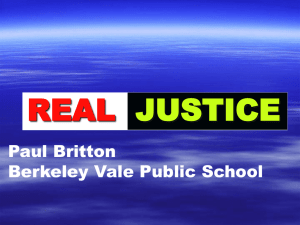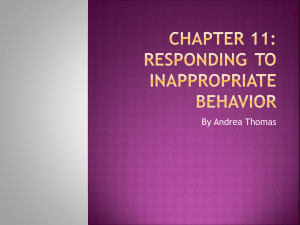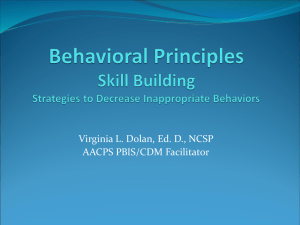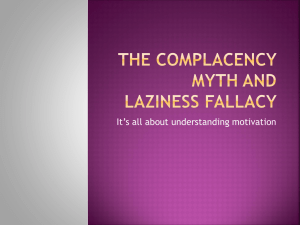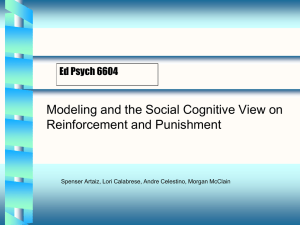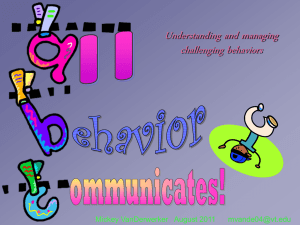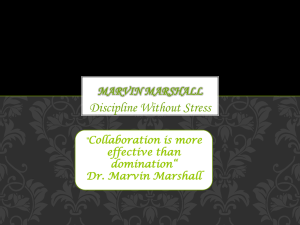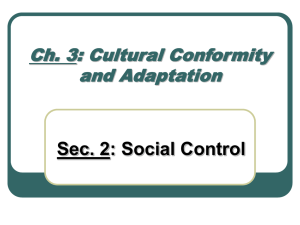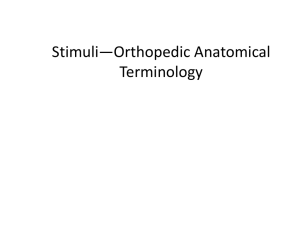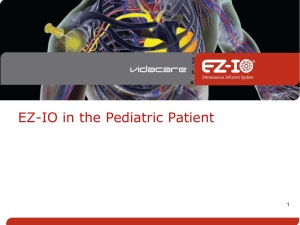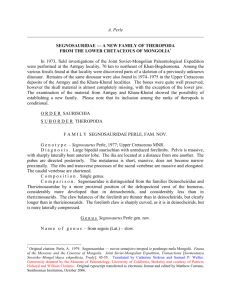Sanctions and Incentives
advertisement
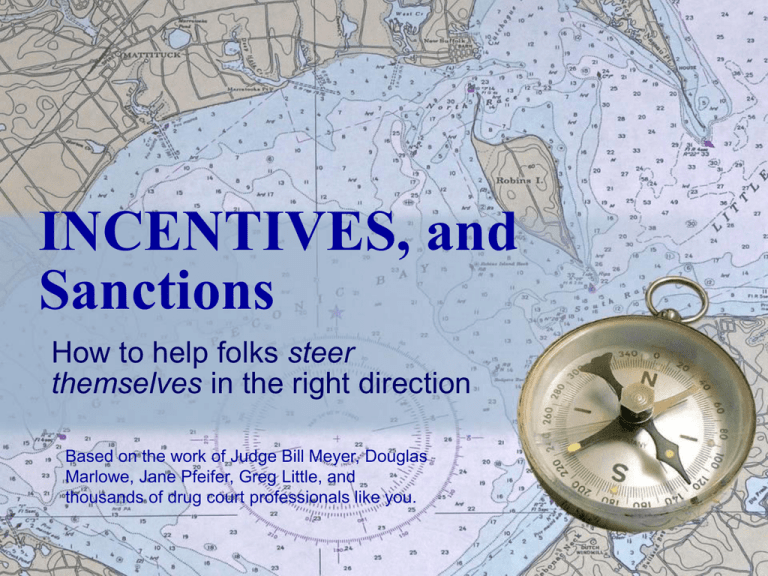
INCENTIVES, and Sanctions How to help folks steer themselves in the right direction Based on the work of Judge Bill Meyer, Douglas Marlowe, Jane Pfeifer, Greg Little, and thousands of drug court professionals like you. Is this new? • NOPE! • This is 60+ years of behavioral science • research. What is new…..is how we can apply this concept to a resistant court involved population. 2 The research • • • • Has been done Is easy to understand Is easy to implement once you understand it. Is just kind of odd for those who are not used to doing it. 3 Why do this strange stuff in Court? Q: What is the problem? A: drug addiction Q: What’s the solution? A: Treatment! Length of time in treatment is the key. The longer a patient stays in treatment: the better they do. Coerced patients stay longer. The purpose of sanctions and incentives is to keep participants engaged in treatment. 4 The enemy is a difficult opponent 5 Remember: the person in front of you is not the enemy: the disease is • We know from research that the addict will • • choose immediate rewards over long term goals. They are prone to poor decision making. We need to catch and redirect undesired behavior, and we need to detect desired behavior and reward, reward, reward…to teach what they should be doing. This target shifts over time for them, and for us, requiring the ultimate in competence and proficiency. 6 Punishment is NOT the goal in the Imposition of Sanctions Changing behavior is the goal. 7 How do we apply these concepts? *certainty, swiftness, severity *positive reinforcement (providing an incentive) & negative reinforcements (removing a sanction) *proximal & distal behaviors *punishment teaches what NOT to do & incentives teach WHAT to do. 8 First Principle: Sanctions should not be painful, humiliating or injurious! 9 First Principle: • What about a sanction is more important in shaping behavior: certainty or severity? • And what does this information say to you about the role of communication between treatment and probation in this model? What does it say about the role of community supervision? What does it say about your role in the model? • What about severity vs. immediacy? • And what does this mean to you about delaying responses? • Perception of fairness is also a key factor! • Punish the act, not the individual-avoid defiance 10 Principle #2 Responses are in the eyes of the behaver 11 Principle #2 • For some, incarceration is NOT the worst punishment • Punishment works best on those who have • something to lose by incarceration. Positive reinforcement works on those who have nothing to lose by incarceration. • Sanctions may be perceived as punishmentscommunication is the key to explaining the difference. 12 Principle # 3 Responses must be of sufficient intensity 13 Principle #3 • Habituation is a concern • Graduated sanctions (and incentives) work • Be aware of interfering with intrinsic motivation. 14 Principle #4 Responses should be delivered for every target behavior. 15 Principle #4 • Key words: • Responses-both types of reinforcement apply. • Target behaviors-proximal and distal. 16 Principle #4 • Tangible rewards only??? • Most valuable rewards you’ve heard of? • The power of immediate and consistent praise that is deserved is immense. • Target behaviors? • What is a target behavior in the first 30 days….60…year…. 17 Principle #5 Responses should be delivered immediately 18 19 Principle #5 • Timing is everything-delay is the enemy-how • • can you as a team work on this issue? As an individual? Intervening behaviors may mix up the message. Brain research supports behavioral observation-dopamine reward system responds better to immediacy. 20 The charts change to meet specific goals for clients at the appropriate time. So they may be generic, or they may be specific to each client’s 14 day period. E.G.: If the client needs more social activities, they can be added into the grid and get a “check off” for that. 21 Principle # 6 Undesirable behavior must be reliably detected 22 Principle #6 • Abstinence must be reliably detected. • Failure to detect puts clients on an intermittent schedule of rewards and sanctions. Sharply less effective. • Consider drug testing and community supervision in this context. 23 Principle #7 Responses must be predictable and controllable 24 Principle #7 • Written agreements and contracts work. • Certainty of consequence has deterrent effect. • Learned helplessness can occur when target behaviors are not clear. 25 Principle #8 Responses may have unintentional side effects 26 Principle #8 • Too excessive a punishment, or an inappropriate punishment may cause learned helplessness. • Avoidance, fear, anger, resistance, escape • Positive reinforcements can have negative consequences if perceived as undeserved. 27 Principle #8 • Frequency of contact with a Judge needs to be matched with the offender’s needs. High-end need more, low end need less. Best intrinsic motivator: praise. There appears to be no ceiling as long as it is sincere. 28 Principle # 9 Behavior does not change by punishment alone 29 All Star lists, candy bars…whatever you can do to promote engagement, and reward desired behavior. 30 Principle #9 • Reinforcement works better in the long run than • • punishment….(and we’re in this race for the long run.) Effects of punishment are temporary, behavior returns when punishment possibility is gone. Punishment is MOST effective when used in combination with other behavior modification techniques such as positive reinforcement. 31 Principle #10 The method of delivery of the response is as important as the response itself. 32 Principle #10 • Perceived unfairness=defiance. Need to • • • • • articulate differences Communication & empathy crucial Placebo effect. Client/Treatment matching MI & Stages of Change The power of a smile from a Judge or authority figure has more power than we think….. 33 Briefly focus on three major themes: • Placebo & engagement • Co-occurring disorders • Physical • Mental • Different risk and needs means different responses. (Who is sitting before you and what should you expect from them and when should you expect it?) 34 You can get sharply better outcomes with placebo • • • • • • Use your skills to engage Use your skills to encourage Use your skills to instill HOPE Sell recovery Use every skill you have to keep them coming back in spite of the pain and agony they are enduring. Early recovery (up to several years) really stinks. 35 Motivation, memory, engagementpublic defender engagement 36 Public Defender teaching in the hallways of the courthouse before court 37 DA training & engaging before Courttreatment team and defense bar present 38 Treatment reps in the courtroom reinforce the message-we all speak the same message 39 This is very difficult work for them: l-------------l--------------l-------------l-------------l Suicidal BAD GOOD VERY GOOD NORMAL BRAIN RANGE l l l l l l Euphoric l l l------------l------------l-------------l------------l Suicidal BAD GOOD VERY GOOD Euphoric RECOVERING BRAIN RANGE 40 Addicts vs. Abusers: Proximal and Distal Behaviors Should we emphasize certain target behaviors during different phases of the program? • What Behaviors? • Why? • How do we respond to show that emphasis? 41 Checklist for your consideration: • Who are they (risk/need) ? • Where are they? (What phase in the program)? • What are the behaviors we are responding to? • • (proximal or distal) What is the response choice and magnitude? How do we deliver and explain the response? 42 Addicts versus Abusers…Proximal and Distal Goals are not the same! Drug Dependence or Addiction Binge pattern Cravings or compulsions Withdrawal symptoms } Abstinence is a distal goal Drug Abuse or Misuse } Abstinence is a proximal goal 1. 2. 3. Collateral needs Regimen compliance is proximal Co-occurring disorder diagnosis Homelessness, chronic unemployment Chronic medical condition (e.g., HIV+, HCV, diabetes) 43 Who is High Risk? • • • • • • • • • • Age during treatment < 25 years Drug use onset < 14 years Criminal onset < 16 years Prior treatment failures History of violence Anti-Social Personality Disorder (APD) Psychopathy (APD + NPD) **** Familial history of crime Criminal associations Drug dependent 44 Marlowe’s Risk Need Matrix HIGH High High Risk/High Needs See prior slide: these are the problem solving court folks! High accountability RISK LOW Low Risk/High Needs Treatment Minimal supervision High treatment needs NEEDS High Risk/Low Needs Abstinence is proximal Use tools to promote rapid compliance. High accountability LOW These are probation folks Low Risk/Low Needs See these folks rarely on a status calendar if there is a problem. This is mostly prevention, early intervention work (bank caseload) 45 What does this mean? • High risk=see weekly or bi-weekly • Low risk= as needed HIT YOUR TARGET 46 Co-occurring disorders-of all types • • • • • • • • • Separate track for some Careful case management, tx accommodation Constant assessment Thoughtful responses Much more patience and room for error over long run-but still a great need to keep on task. Longer time in program Medication management is proximal-watch jail Pro-Active field services are crucial Remember that manipulation happens no matter what the disabling disease. 47 Patience: we are in this for the long haul. Normal methamphetamine addict 15 months post abstinence 48


